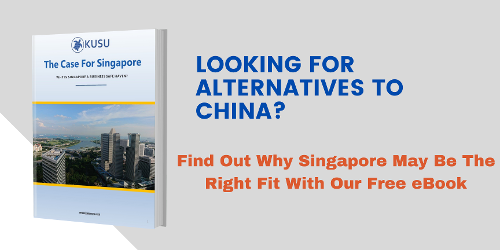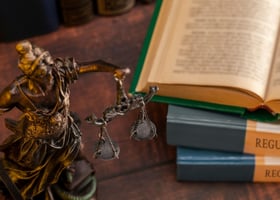A 2021 article by the Hill reports that in late December the US Department of Homeland Security...
IP Protection And China
Ensuring that your ideas remain your own and ensuring you get to reap the rewards from your own ideas serve as the conceptual basis of intellectual property (IP). However, enforcing intellectual property is a lot harder in practice than it is on paper.
In this week’s article, we will be discussing IP and the means of enforcing IP. More specifically, we will be discussing what IP is, the different types of IPs, examples of IP infringement, where IP is least and most safe, the role of the World Trade Organization (WTO), and Chinese IP theft accusations.
%20(8).png?width=600&name=Untitled%20(600%20%C3%97%20350%20px)%20(8).png)
Definition of IP
The World Intellectual Property Organization defines IP as “...creations of the mind, such as inventions; literary and artistic works; designs; and symbols, names and images used in commerce.”
The British Government adds that while creating IP guarantees ownership, IP ownership can also be bought and sold, be shared within a group, and be property of an individual and a business.
While seemingly straightforward, the matter of IP ownership is incredibly complex and difficult to navigate, not to mention expensive if done incorrectly.
Types of IP
There are four types of legal instruments used by individuals and businesses to enforce IP: Patents, trademarks, copyrights, and trade Secrets. According to the United States Patent and Trademark Office, a patent refers to a type of document awarded to inventors that guarantees their ownership over their own novel invention. Three types of patents exist: Utility, design, and plant patents.
On the other hand, “A trademark is a word, name, symbol, or device that is used in trade with goods to indicate the source of the goods and to distinguish them…” Where copyrights mainly protect artistic creations, according to the World Intellectual Property Organization, trade secrets are a type of IP that revolve around a specific type of information which can be bought and sold.
Infringement of IP
IP infringement sees the improper use of IP beyond the established and allowed legal limitations. It may also see claims of IP ownership by individuals who have no real claim to ownership. However, depending on the type of IP, the legal definition for infringement may differ. This is generally the definition of copyright infringement, writes Forbes.
According to Cornell Law School, patent infringement applies only when all elements protected by a patent are made, used, or sold by anyone other than the patent owner. According to the Canadian Intellectual Property Office, trademark infringement occurs when a registered trademark is imitated to the point the two products can be confused with one another, whereas trade secret infringement sees the unauthorised disclosure of said secret.
Safety of IP
Understanding where your IP is safest and least safe is paramount. The International Property Rights Index is often a good place to start when deciding where to expand business and when deciding if a country is suitable or not.
The top five safest countries in terms of IP protection include: 1) Switzerland; 2) Singapore; 3) New Zealand; 4) Finland; 5) Luxemburg; 6) United States; 7) Netherlands; 8) Norway; 9) Denmark; and 10) Austria.
The ten least safe countries in terms of IP protection include: 1) Haiti; 2) Venezuela; 3) Yemen; 4) Angola; 5) Bangladesh; 6) Democratic Republic of Congo; 7) Nigeria; 8) Bolivia; 9) Chad; and 10) Zimbabwe.
Role of the WTO
The World Trade Organization (WTO) was at the forefront of IP protection. They helped introduce the concept of IP rights to the multilateral trading system through the Agreement on Trade-Related Aspects of Intellectual Property Rights (TRIPS) back in the 1980s and the 1990s during the Uruguay Round of negotiations.
This Agreement was based around the various other agreements that created the World Intellectual Property Organization. This Agreement was the only Agreement that details IP rights enforcement at the multilateral level while also serving as the only Agreement that ensured all WTO member countries had the same basic IP standards.
Accusations Against China
The Carnegie Endowment wrote, “China’s practice of pressuring foreign companies into sharing trade secrets and intellectual property with Chinese corporate partners has disproportionate impact on U.S. companies built around specific technology rights, know-how, and data.”
The alleged IP theft by Chinese companies has led to significant financial costs to the American economy. However, American lawmakers have been struggling to figure out how to combat the alleged IP theft.
Conclusion
In conclusion, IP protection is a very serious matter. Understanding what type of IP your business’ product is classified, the type of legal instrument it could be protected with, the risks that come with the instrument, where your IP is safest, and the international protections afforded to your IP is paramount.
We here at Kusu understand and uphold the principles of IP rights, hence why we are based in Singapore, the country with the second best IP protection regime worldwide behind only Switzerland. We at Kusu are committed to IP protection and to helping you and your company with any and all inquiries regarding manufacturing in Singapore and Southeast Asia.
-1.jpg?width=146&height=50&name=Kusu%20(1)-1.jpg)



.png?height=200&name=Untitled%20design%20(10).png)
